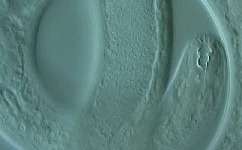Seabed study shows inhabitants' diversity

The tiny creatures that live in seabed sediments are far more genetically varied than we thought – and they're spread around the oceans according to similar rules to those governing the distribution of bigger plants and animals, a recent study shows.
The findings answer a question that's kept scientists wondering for years – do these creatures, including groups like flatworms, nematodes and minute crustaceans known as copepods, inhabit particular ecological niches to which they're specially adapted, like bigger plants and animals do?
Or are they spread around the globe so that everything is effectively found everywhere it can survive? The answer, it turns out, is closer to the first possibility – some species turn up all over the place, but many others are confined to specialised niches and particular geographical areas.
Knowing this will improve our understanding of how ocean life is adapting to environmental change; shifts in the communities of these animals, known as meiofauna, will ultimately have a major impact on bigger plants and animals, many of which are economically and socially important.
An international team of scientists carried out genetic analysis of the life found in 66 samples of sediments taken at low tide from beaches around the north Atlantic – in the UK, France, Spain, Portugal and Gambia. They looked for particular sections of well-known DNA that work as unique markers for particular animal families, letting them quickly get a handle on exactly which species live in each place.
They found far more difference between the communities in each location than anticipated, with many species only living in one place. Most of the species they found haven't yet been formally identified, but it's clear there's far more diversity than previously thought, and that a vast number of undiscovered species are still out there living in the seabed.
'Because microscopic species are very small and are present in their billions, there is considerable debate about whether or not they show any geographical and ecological species ranges, as do larger animals,' says Dr Vera Fonseca of the Zoological Research Museum Alexander Koenig in Bonn, lead author of the study. 'Our work shows that within these communities, some species are local, preferring a particular set of environmental conditions, while others are distributed far more widely.'
Trying to distinguish and identify all these organisms in the traditional way, by picking out subtle anatomical differences under the microscope, would have taken years of work by a whole team of highly-trained specialists in the different groups involved. Genetic analysis, on the other hand, let the researchers discriminate between thousands of species from many different evolutionary families near-instantaneously. The methods can pick up not just meiofauna but also much smaller life-forms like protists, fungi and bacteria, giving a broader view of each ecosystem's composition.
'Because identifying microscopic animals is challenging, the modern molecular genetic tools the group used revealed these patterns for the first time,' explains Dr Simon Creer of Bangor University, the study's senior author. 'Trying to do this using traditional taxonomic methods simply wouldn't be possible - you couldn't hope to assess the large-scale patterns of diversity in these communities by looking at individual animals under the microscope.'
DNA analysis turned up facts that would probably never have come from the traditional approach; for instance, predatory flatworms' delicate bodies preserve badly, so they are hard to examine under the microscope and their importance in seabed ecosystems has tended to be underestimated. But Creer says the team's work shows that they are consistently the second-most species-rich group, behind nematodes.
He speculates that the widespread animals turned up in the survey may be able to tolerate a wider range of conditions than the ones confined to a small area - or they may just have better ways of getting to new places.
The findings could have practical value as we try to understand how marine life will be affected by global trends like climate change and ocean acidification. Many of these animals will need to migrate to new areas if they're going to cope with these changes; others will face new interactions with unfamiliar organisms that move into their neighbourhood. To plan how we manage the changing ocean environment, we need to understand how the ecosystems of the seabed will adapt, and grasping the true diversity of these microscopic communities will be an important part of this.
Meiofauna – loosely speaking, animals bigger than bacteria but smaller than a millimetre or so across – play a crucial part in moving energy and nutrients through ocean ecosystems. They eat even smaller plants and animals, and are in turn eaten by bigger creatures, so changes to their communities could trigger profound shifts in whole marine ecosystems.
The paper appears in Global Ecology and Biogeography.
More information: "Metagenetic analysis of patterns of distribution and diversity of marine meiobenthic eukaryotes." Vera G. Fonseca, Gary R. Carvalho, Ben Nichols, Christopher Quince, Harriet F. Johnson, SimonP.Neill, John D. Lambshead, W. Kelley Thomas, Deborah M. Power and Simon Creer. Global Ecology and Biogeography (2014) 23 1293-1302. DOI: 10.1111/geb.12223
Journal information: Global Ecology and Biogeography
Provided by PlanetEarth Online
This story is republished courtesy of Planet Earth online, a free, companion website to the award-winning magazine Planet Earth published and funded by the Natural Environment Research Council (NERC).




















